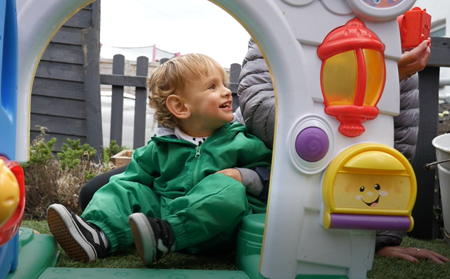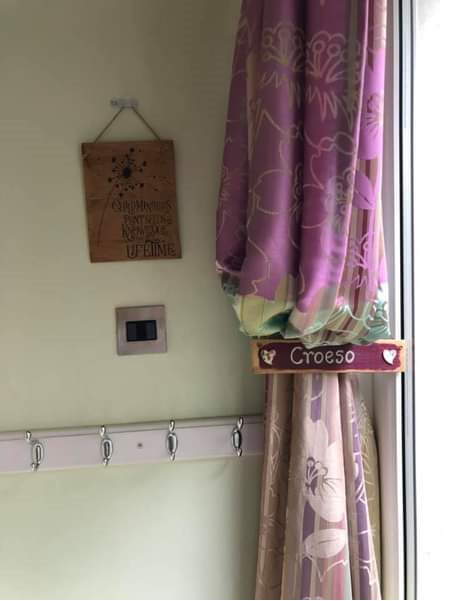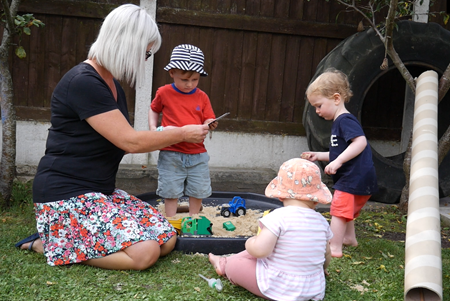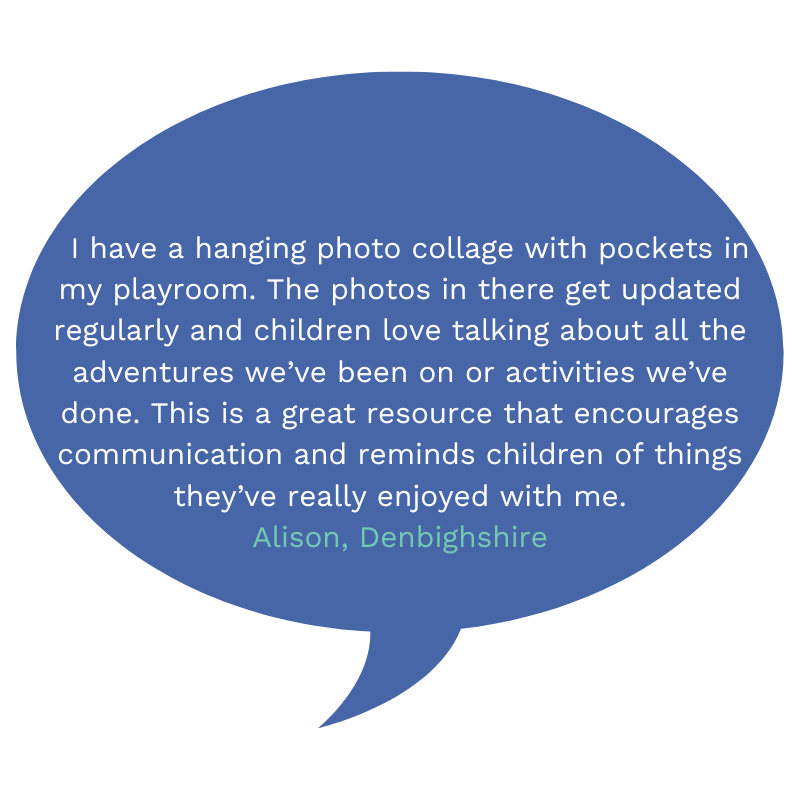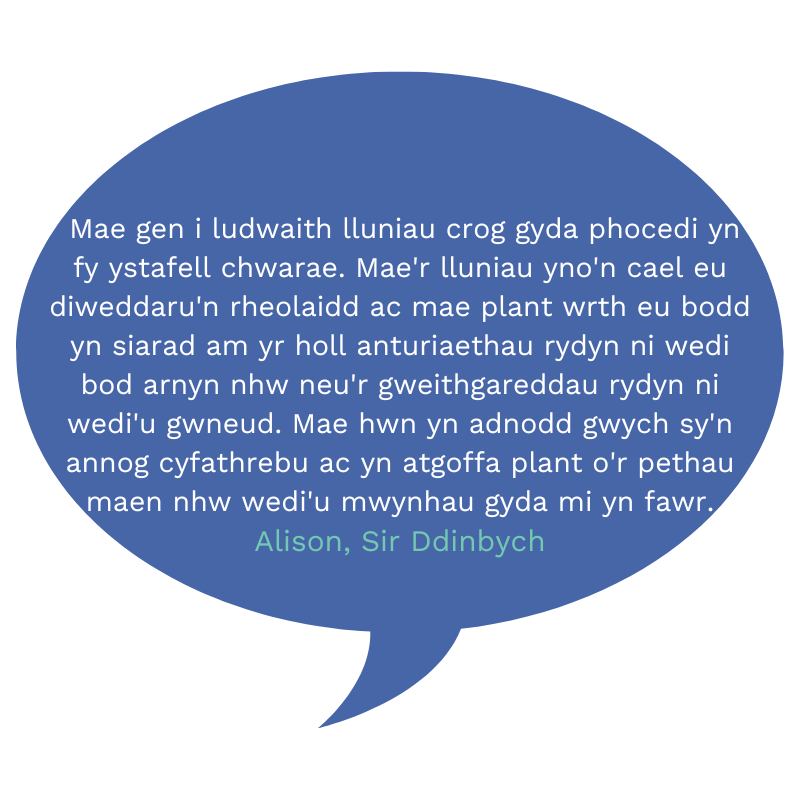Exploring and combining some of the key points in this section alongside the other sections will help as you review and enhance the emotional climate you create for the children in your care in a responsive way, over time. Digest and use the ideas here to trigger questions, reflection and also new thinking as you continually notice and consider how well your provision supports a sense of welcome, familiarity, belonging and connection. Don’t forget to document the process of review and development as this will feed into your future planning and is a great way to capture the changes made and impact noticed.
“For me, creating a secure emotional environment is the priority. If children don’t feel settled, connected and ‘at home’, they just won’t thrive. It’s a complex, sensitive task and I think a multi-layered approach is needed.”
Elizabeth Jarman
Cortisol
When children and families start attending your setting or even for those who have been with you for a while, it’s important to consider how their cortisol levels might be affecting the way they are feeling emotionally. Cortisol is a stress hormone. Research shows us that raised levels of cortisol affects the way we respond and function, sometimes in a negative way. New places, new people, new noises or new smells for example can all act as cortisol triggers, putting us on high alert and sometimes making children, or adults feel overwhelmed and unsettled. It’s important to understand what cortisol does to the brain and body so you can help to manage this, there are links to this in the further reading section.
Relationships and Attachment
The response that parents have to your setting and the interactions they have with you will affect their children’s perceptions and the way that they will subsequently respond. The more you can find ways to build meaningful relationships with families the better for everyone. Open dialogue with parents will allow you to co-construct a consistent, shared way to support their child and make transitions smoother, helping their children to understand what’s going on around them and feel more emotionally secure. This also needs to be on-going.
Developing a strong, healthy attachment with the children you care for is also really important. Getting to know them, being present, ‘available’, interested, engaged and interacting as an active play partner is key.
Transitions and the environment
Transitions take place throughout the day. It’s not just the big transitions like arriving or leaving that can trigger raised cortisol and maybe unsettle children in your care. It could also be triggered by using a new resource, having a nappy changed in a different room, going into the garden or out for a walk. We are all continually making adjustments and interpreting changes in our surroundings or in response to the experiences we have. If we tune in to these less obvious changes in behaviour as they occur, we will perhaps gain a better understanding of why children respond the way that they do and how we can support transition and change in a sensitive, pre-emptive way.
The physical environment can really support this whole process and can be used to help establish a sense of welcome, familiarity, belonging and connection. Blending of some of the key considerations below will help to generate more emotionally secure places.
Entrances and exits
Think about the way that your space currently helps or hinders the transitional process. There are lots of practical ideas and inspiration from the project group in the case studies section. We often focus on the ‘way in’, but the transition out is also important too, for parents after drop-off and also children on the way home.
Generating a feeling of ‘connectedness’, for example using objects or images to trigger recall about positive shared experiences can all help.
You may want to consider adding some of the following items to engage families even before you open the front door or as they step into the setting :
- A welcome sign
- Flowers or herbs
- Things that have been created by the children in your care for example decorated plant pots, painted stones or shells or bird feeders
- Curiosities like animal statues, unusual shells, pebbles or wind chimes
- A photo of something you did together in your setting recently to trigger recall
- A place to sit together
- Pegs with individual children’s names and photos
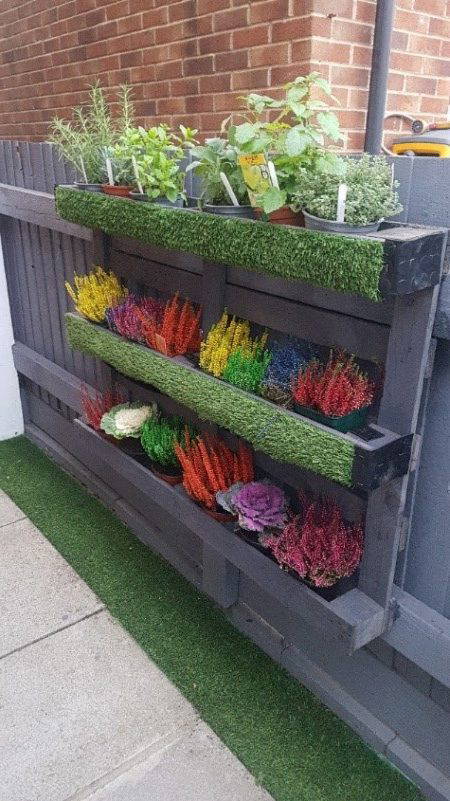
Secure transitional spaces and objects
Having a transitional space where children can choose to start off while they adjust to being in your setting on arrival can be beneficial. This can be used for them to watch from for a while or retreat to during the day, maybe to regulate their emotions. It can be useful for some of the children in your care, especially if the transitional space is simply resourced with that child in mind. Often children will have a favourite item or ‘object of attachment’ in your setting, for example a favourite car, doll, pebble or ball. Perhaps add one of these known favourites into your transitional space. Sometimes children will bring special items with them from home. These material things, or ‘transitional objects’ will often provide a sense of emotional security as they are a connection with home. The organisation of safe places for these treasures is worth considering and how children can access them when needed.
Staying connected by triggering recall
Adding visuals of the children you care for, as well as their special people or places that are significant to them, into your environment can help build positive connections. It helps to personalise the environment in your home. Auditory connection is also a useful tool. You could record short messages from parents on a digital device (for example a mobile phone or tablet) for the children to access or hear throughout the day. This could include messages such as ‘Have a lovely day, have fun and I’ll see you later’.
Reflect!
- Think about how you support attachments in your setting in relation to the environment. What could be developed or improved?
- What’s already supportive and working well to support transitions in your setting? What could be developed or improved?
- Next time you are introducing something new, maybe a resource or going somewhere unfamiliar, take time to notice how different children in your care respond. Look for subtle changes in behaviour. How do different children tackle a new challenge or interact in a new place? Do they stay close to you? Do they seek a security item like a blanket or dummy? Observe what they show you and be aware of how they might be feeling. Think about ways that you can reassure and support in a gentle, responsive way.
- What are the objects of attachment in your setting? If they are popular with a few children in your care, it can be worth getting multiple copies of the same resource!
“When considering how emotionally secure your environment is, it’s always important to start from the child’s point of view. Observe them and the way they are responding currently. Depending on their development, consult with them and provide time and space to listen their thoughts and feelings.”
Elizabeth Jarman
Further reading
- PACEY CEY smart- Transitions
- PACEY resources- Transitions
- Attachment and child development. NSPCC
- The object of my affection: attachment security and material culture. University of York
- Toddlers’ stress during transition to childcare. Taylor Francis Online
- Transitional objects. Suffolk County Council
- Transitions. The British Association for Early Childhood Education
Exploring and combining some of the key points in this section alongside the other sections will help as you review and enhance the emotional climate you create for the children in your care in a responsive way, over time. Digest and use the ideas here to trigger questions, reflection and also new thinking as you continually notice and consider how well your provision supports a sense of welcome, familiarity, belonging and connection. Don’t forget to document the process of review and development as this will feed into your future planning and is a great way to capture the changes made and impact noticed.
“I fi, creu amgylchedd emosiynol diogel yw'r flaenoriaeth. Os nad yw plant yn teimlo eu bod wedi setlo, yn gysylltiedig ac 'yn gartrefol', ni fyddant yn ffynnu. Mae'n dasg gymhleth, sensitif a chredaf fod angen dull aml-haenog.”
Elizabeth Jarman
Cortisol
Pan fydd plant a theuluoedd yn dechrau mynychu eich lleoliad neu hyd yn oed i’r rhai sydd wedi bod gyda chi am gyfnod, mae’n bwysig ystyried sut y gallai eu lefelau cortisol fod yn effeithio ar y ffordd maen nhw’n teimlo’n emosiynol. Hormon straen yw cortisol. Mae ymchwil yn dangos i ni fod lefelau uwch o gortisol yn effeithio ar y ffordd rydym yn ymateb ac yn gweithredu, weithiau mewn ffordd negyddol. Gall lleoedd newydd, pobl newydd, synau newydd neu arogleuon newydd i gyd weithredu fel sbardunau cortisol, gan ein gwneud yn bryderus ac weithiau gwneud i blant, neu oedolion deimlo eu bod yn cael eu gorlethu ac yn ansefydlog. Mae’n bwysig deall beth mae cortisol yn ei wneud i’r ymennydd a’r corff fel y gallwch chi helpu i reoli hyn, mae dolenni i hyn yn yr adran ddarllen bellach.
Perthnasoedd ac Ymlyniad
Bydd yr ymateb sydd gan rieni i’ch lleoliad a’u rhyngweithiadau gyda chi yn effeithio ar ganfyddiadau eu plant a’r ffordd y byddant yn ymateb wedi hynny. Po fwyaf y gallwch ddod o hyd i ffyrdd o adeiladu perthnasoedd ystyrlon â theuluoedd, gorau oll i bawb. Bydd deialog agored gyda rhieni yn caniatáu i chi gyd-lunio ffordd gyson a rennir i gefnogi eu plentyn a gwneud trawsnewidiadau yn llyfnach, gan helpu eu plant i ddeall beth sy’n digwydd o’u cwmpas a theimlo’n fwy diogel yn emosiynol. Mae angen i hyn fod yn barhaus hefyd.
Mae datblygu ymlyniad cryf, iach gyda’r plant rydych yn gofalu amdanynt hefyd yn bwysig iawn. Mae dod i’w hadnabod, bod yn bresennol, ‘ar gael’, ymddiddori, ymgysylltu a rhyngweithio fel partner chwarae gweithredol yn allweddol.
Trawsnewidiadau a'r amgylchedd
Mae trawsnewidiadau’n digwydd drwy gydol y dydd. Nid dim ond y trawsnewidiadau mawr fel cyrraedd neu adael a all sbarduno cortisol uwch ac efallai aflonyddu plant yn eich gofal. Gellid ei sbarduno hefyd drwy ddefnyddio adnodd newydd, newid cewyn mewn ystafell wahanol, mynd i’r ardd neu allan am dro. Rydym i gyd yn barhaus yn gwneud addasiadau ac yn dehongli newidiadau yn ein hamgylchedd neu mewn ymateb i’r profiadau a gawn ni. Os ydym yn tiwnio i mewn i’r newidiadau llai amlwg hyn mewn ymddygiad wrth iddynt ddigwydd, mae’n bosib y byddwn yn ennill gwell dealltwriaeth o pam mae plant yn ymateb i’r ffordd y maent yn gwneud a sut y gallwn gefnogi trawsnewid a newid mewn ffordd sensitif, ragataliol.
Gall yr amgylchedd ffisegol wir gefnogi’r broses gyfan hon a gellir ei defnyddio i helpu i sefydlu ymdeimlad o groeso, cynefindra, perthyn a chysylltiad. Bydd cyfuno rhai o’r ystyriaethau allweddol isod yn helpu i gynhyrchu lleoedd mwy diogel yn emosiynol.
Mynedfeydd ac allanfeydd
Meddyliwch am y ffordd y mae eich gofod ar hyn o bryd yn helpu neu’n rhwystro’r broses o drawsnewid. Mae yna lawer o syniadau ymarferol ac ysbrydoliaeth gan grŵp y prosiect yn yr adran astudiaethau achos. Rydym yn aml yn canolbwyntio ar y ‘ffordd i mewn’, ond mae’r trawsnewid allan yn bwysig hefyd, i rieni ar ôl gollwng a hefyd plant ar y ffordd adref.
Gall cynhyrchu teimlad o ‘gysylltedd’, er enghraifft drwy ddefnyddio gwrthrychau neu luniau i sbarduno galw i gof am brofiadau cadarnhaol a rennir oll helpu.
Mae’n bosib yr hoffech ystyried ychwanegu rhai o’r eitemau canlynol i ennyn diddordeb teuluoedd hyd yn oed cyn i chi agor y drws ffrynt neu wrth iddynt gamu i’r lleoliad:
- Arwydd croeso
- Blodau neu berlysiau
- Pethau sydd wedi’u creu gan y plant yn eich gofal er enghraifft potiau planhigion sydd wedi’u haddurno, cerrig neu gregyn wedi’u paentio neu fwydwyr adar
- Petheuach megis cerfluniau anifeiliaid, cregyn anarferol, cerrig mân neu glychau gwynt
- Llun o rywbeth a wnaethoch gyda’ch gilydd yn eich lleoliad yn ddiweddar i sbarduno galw i gof
- Lle i eistedd gyda’ch gilydd
- Pegiau gydag enwau a lluniau plant unigol

Mannau a gwrthrychau trawsnewidiol diogel
Gall fod yn fuddiol cael lle trawsnewid lle gall plant ddewis cychwyn wrth iddynt addasu i fod yn eich lleoliad wrth gyrraedd. Gellir defnyddio hyn iddynt wylio ohono am ychydig neu encilio yn ystod y dydd, efallai i reoleiddio eu hemosiynau. Gall fod yn ddefnyddiol i rai o’r plant yn eich gofal, yn enwedig os oes gan y gofod trawsnewid adnoddau syml gyda’r plentyn hwnnw mewn golwg. Yn aml bydd gan blant hoff eitem neu ‘wrthrych ymlyniad’ yn eich lleoliad, er enghraifft hoff gar, dol, carreg neu bêl. Efallai y dylech ychwanegu un o’r ffefrynnau hysbys hyn i’ch gofod trawsnewid. Weithiau bydd plant yn dod ag eitemau arbennig gyda nhw o gartref. Yn aml bydd y pethau materol hyn, neu ‘wrthrychau trawsnewidiol’ yn darparu ymdeimlad o ddiogelwch emosiynol gan eu bod yn gysylltiad â chartref. Mae’n werth ystyried trefnu lleoedd diogel ar gyfer y trysorau hyn a sut y gall plant gael mynediad atynt yn ôl yr angen.
Aros yn gysylltiedig drwy sbarduno galw i gof
Gall ychwanegu delweddau o’r plant rydych yn gofalu amdanynt, yn ogystal â’u pobl arbennig neu leoedd sy’n arwyddocaol iddynt, at eich amgylchedd helpu i ddatblygu cysylltiadau cadarnhaol. Mae’n helpu i bersonoleiddio’r amgylchedd yn eich cartref. Mae cysylltiad clywedol hefyd yn offeryn defnyddiol. Gallech recordio negeseuon byr gan rieni ar ddyfais ddigidol (er enghraifft ffôn symudol neu lechen) i’r plant eu cyrchu neu eu clywed drwy gydol y dydd. Gallai hyn gynnwys negeseuon megis ‘’Mwynha dy ddiwrnod, joia a wela i di’n nes ymlaen’.
Myfyriwch!
- Meddyliwch sut rydych chi’n cefnogi atodiadau yn eich lleoliad mewn perthynas â’r amgylchedd. Beth ellid ei ddatblygu neu ei wella?
- Beth sydd eisoes yn gefnogol ac yn gweithio’n dda i gefnogi trawsnewidiadau yn eich lleoliad? Beth ellid ei ddatblygu neu ei wella?
- Y tro nesaf y byddwch chi’n cyflwyno rhywbeth newydd, efallai adnodd neu’n mynd i rywle anghyfarwydd, cymerwch amser i sylwi sut mae gwahanol blant yn eich gofal yn ymateb. Chwiliwch am newidiadau cynnil mewn ymddygiad. Sut mae gwahanol blant yn mynd i’r afael â her newydd neu’n rhyngweithio mewn lle newydd? Ydyn nhw’n aros yn agos atoch chi? Ydyn nhw’n edrych am eitem ddiogelwch megis blanced neu ddymi? Arsylwch yr hyn maen nhw’n ei ddangos i chi a byddwch yn ymwybodol o sut y gallen nhw fod yn teimlo. Meddyliwch am ffyrdd y gallwch dawelu meddwl a chefnogi mewn ffordd dyner, ymatebol.
- Beth yw’r gwrthrychau ymlyniad yn eich lleoliad? Os ydyn nhw’n boblogaidd gydag ychydig o blant yn eich gofal, gall fod yn werth cael sawl copi o’r un adnodd!
“Wrth ystyried pa mor ddiogel yn emosiynol yw eich amgylchedd, mae bob amser yn bwysig cychwyn o safbwynt y plentyn. Arsylwch arnyn nhw a'r ffordd maen nhw'n ymateb ar hyn o bryd. Yn dibynnu ar eu datblygiad, ymgynghorwch â nhw a darparwch amser a lle i wrando ar eu meddyliau a'u teimladau.”
Elizabeth Jarman
Darllen pellach
- PACEY CEY smart- Trawsnewidiadau
- Adnoddau PACEY- Trawsnewidiadau
- Ymlyniad a datblygiad plant. NSPCC
- The object of my affection: attachment security and material culture. Prifysgol Efrog
- Toddlers’ stress during transition to childcare. Taylor Francis Online
- Transitional objects. Cyngor Sir Suffolk
- Transitions. The British Association for Early Childhood Education

